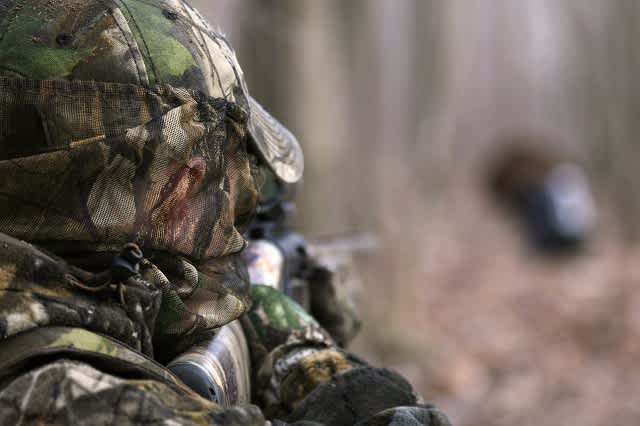Safe Turkey Hunting Tactics are Also Best Practices for Bagging a Bird
Tammy Sapp 02.24.12

Those planning to hunt turkeys this spring likely will spend hours practicing their calling, patterning shotguns and assembling gear. Spring turkey hunters should also devote themselves to learning about hunter safety.
“Safe turkey hunting strategies are well worth learning because they’re also tactics that can put you in the best position to take a gobbler,” said Tom Hughes, the National Wild Turkey Federation’s assistant vice president for education and outreach programs.
Running and gunning is a popular style of turkey hunting that consists of moving through the woods while calling. However, Hughes recommends an alternative strategy that will help you be safer and more successful.
“Calling while moving stacks the deck the wrong way. Another hunter could mistake you for a wild turkey,” Hughes said. “Instead, hunters should protect themselves by setting up against a tree taller than their head and wider than their shoulders before they start calling. Doing this also makes you more prepared for a gobbler that shows up more quickly than you expected.”
Visit an online turkey hunting forum and you’ll probably run across turkey hunters who say they like to sneak up on a gobbler, which is a bad idea according to Hughes.
“You might think you’re stalking a turkey, but you could actually be slipping up on another hunter,” Hughes said. “You should always adopt a skeptical attitude when you hear turkey calling. Good callers can sound as convincing as actual turkeys.”
In addition to safety concerns, the odds are against you when it comes to sneaking up on a gobbler. Turkeys have sharp eyesight and hear pretty well, too. You’d be better off setting up and calling a bird to you.
Another safety measure calls for turkey hunters to make a fashion statement. First, hunters should not wear red, white, blue or black, which are colors associated with a gobbler. In addition, while blaze orange provides a measure of safety during fall, Hughes advises spring turkey hunters to avoid wearing blaze orange.
“Orange is closest to red in the color spectrum, and it can be mistaken for the red on a gobbler’s head,” Hughes said. “We saw that in Pennsylvania when they still required blaze orange during their spring turkey season. A study revealed that some incidents occurred when hunters shot at something moving that they thought was red, when in fact it was another hunter wearing blaze orange. Another issue related to orange was hunters reported hearing a turkey and seeing movement but no orange, so they shot. Basically, both the presence and absence of blaze orange was a problem during spring turkey season.”
Your best bet when turkey hunting is to wear camouflage or drab greens and browns including undershirts, socks, gloves and a face mask.
Shooting at sounds, color and movement is a big no-no. Hughes recommends that hunters be absolutely certain that what they intend to shoot is a legal turkey.
“Demand multiple points of identification. If you see movement, do you also see the turkey’s beard? Feet and wings? Is it really a turkey? Plus, seeing the gobbler’s eyes is a good indicator that the bird is within range.”
Hughes also recommends being careful when carrying decoys, especially gobbler decoys. Using an earth-tone colored bag to hold the decoy as you move from place to place is a smart safety measure.
The shot shell you choose is another safety factor to consider. Shot size larger than #4 can be more dangerous to other hunters. Plus, it’s unlikely to produce a dense enough pattern for a quick, clean kill. Research shows that #4 to #6 lead shot is best, though some modern alloy loads in #7 have great pattern density and enough downrange energy to kill a gobbler out to 40 yards.
Shot shell technology has improved throughout the years, however, it shouldn’t be taken as an invitation to shoot farther than the recommended 40 yards with any load. If you’re shooting beyond 40 yards, it’s harder to positively identify your target. Plus, there are hunter safety issues associated with long-range shots.
You can learn more about how to stay safe while hunting by taking an online hunter safety course at http://www.hunter-ed.com. The training offered at this site is approved by the state agencies responsible for hunter education, and it’s the same material that’s taught in the classroom.
Studying at www.hunter-ed.com is free. Those who must be certified before they can buy a hunting license pay a one-time fee, which is due only if they pass the test. Students can take the test as many times as they need to pass it. Online hunter safety courses are available in participating states, so visit hunter-ed.com to take a course specific to your state.
To learn more about defensive turkey hunting tactics, visit the National Wild Turkey Federation’s website at http://www.nwtf.org/tips_adventures/tips.php?id=11551
About Kalkomey
Kalkomey, parent company of hunter-ed.com, is the official provider of recreational safety education products for all 50 states. Our print and Internet courses have been providing official safety certification since 1995. We provide safety courses in boating, hunting, bowhunting, and off-road vehicle (ORV) and snowmobile operation. For more information, visit http://www.kalkomey.com/.

